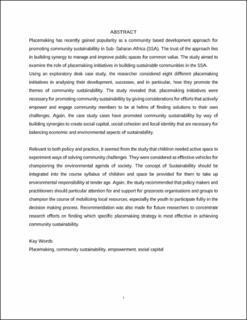| dc.description.abstract | ABSTRACT
Placemaking has recently gained popularity as a community based development approach for promoting community sustainability in Sub- Saharan Africa (SSA). The trust of the approach lies in building synergy to manage and improve public spaces for common value. The study aimed to examine the role of placemaking initiatives in building sustainable communities in the SSA.
Using an exploratory desk case study, the researcher considered eight different placemaking initiatives in analysing their development, successes, and in particular, how they promote the themes of community sustainability. The study revealed that, placemaking initiatives were necessary for promoting community sustainability by giving considerations for efforts that actively empower and engage community members to be at helms of finding solutions to their own challenges. Again, the case study cases have promoted community sustainability by way of building synergies to create social capital, social cohesion and local identity that are necessary for balancing economic and environmental aspects of sustainability.
Relevant to both policy and practice, it seemed from the study that children needed active space to experiment ways of solving community challenges. They were considered as effective vehicles for championing the environmental agenda of society. The concept of Sustainability should be integrated into the course syllabus of children and space be provided for them to take up environmental responsibility at tender age. Again, the study recommended that policy makers and practitioners should particular attention for and support for grassroots organisations and groups to champion the course of mobilizing local resources, especially the youth to participate fully in the decision making process. Recommendation was also made for future researchers to concentrate research efforts on finding which specific placemaking strategy is most effective in achieving community sustainability. | |
